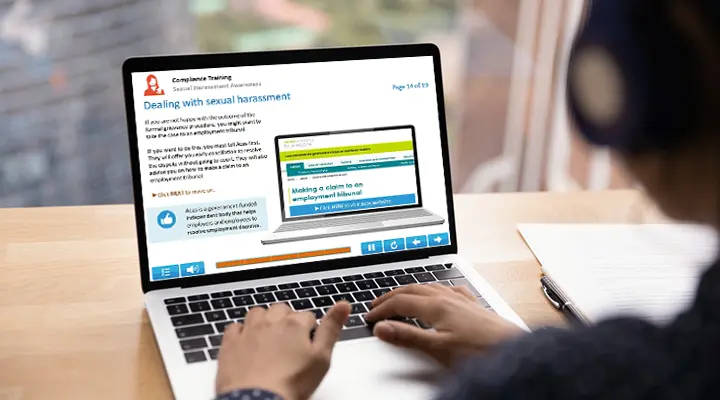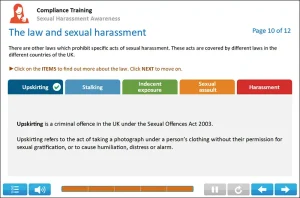Sexual harassment remains a serious workplace issue. According to the ONS Crime Survey for England and Wales, 8% of women and 3% of men experienced sexual harassment in the past year. Of those who experienced sexual harassment, 26% said it happened at work. Despite this, many employers are still unclear about their legal responsibilities to prevent and address sexual harassment at work.
This article explains your legal obligations under current UK legislation, highlights why prevention of sexual harassment in the workplace is important, outlines practical steps you can take to create a harassment-free workplace and provides insight on what you should do if your employee raises a sexual harassment complaint.
For employee-focused guidance, see our article What can I do about sexual harassment at work?
What are your legal obligations regarding sexual harassment in the workplace?
Several pieces of legislation require you to protect your employees from sexual harassment at work. These laws work together and outline clear responsibilities you must understand and act on to keep your workers safe.
The Health and Safety at Work etc. Act 1974
The Health and Safety at Work etc. Act 1974 is the primary health and safety law. It places a legal duty on employers to protect the health, safety and welfare of their employees and others who may be affected by their work activities.
This Act requires you to keep the workplace safe for everyone. Sexual harassment threatens wellbeing and mental health, so preventing it is part of your wider health and safety duties.
The Management of Health and Safety Regulations 1999
The Management of Health and Safety Regulations 1999 require employers to carry out a risk assessment and take steps to reduce any identified risks.
Your risk assessment must consider all the health and safety risks to your employees, including the risk of sexual harassment.
You need to think carefully about how sexual harassment might happen in your workplace and what you can do to prevent it. Consider the risks of sexual harassment of staff by other workers, customers, suppliers, contractors and anyone else your employees interact with through their work.
Once you have identified the risks, you need to implement measures to reduce those risks and ensure your risk assessment is reviewed and updated regularly.
The Equality Act 2010
The Equality Act 2010 protects people from discrimination and harassment based on nine protected characteristics, which include sex and sexual orientation. The act makes it clear that sexual harassment is unlawful.
Your primary obligation under this Act, concerning sexual harassment, is to take all reasonable steps to prevent sexual harassment in your workplace.
If sexual harassment does occur and you can’t prove you took all reasonable steps to prevent it, you will be legally liable for it.
The Act also prohibits victimisation. This means you can’t treat someone differently at work, exclude them from opportunities, or make their working life difficult because they have made a complaint about sexual harassment. Employees need to feel safe and supported to speak up about harassment without fear that doing so will negatively impact their working life.
The Worker Protection Act 2023
The Worker Protection Act 2023 came into effect in October 2024. It requires employers to take a proactive approach to preventing sexual harassment in the workplace.
You are expected to anticipate how harassment could occur in your workplace and to implement appropriate preventative measures before an incident occurs.
If harassment does occur despite these preventative measures, you must take immediate action to prevent it from happening again.
You must be able to demonstrate that you are continually working to create a harassment-free environment.
Why is it important to prevent sexual harassment in the workplace?

Everyone has a right to work in an environment that is safe, respectful, and free from harassment. Sexual harassment can have long-lasting harm on individuals and the wider organisation.
The impact of failing to prevent sexual harassment is serious and far-reaching:
Workers’ mental and physical health
Sexual harassment can severely affect employees’ mental and physical well-being. Victims often experience anxiety, depression, stress-related illnesses, and difficulty sleeping.
Workplace performance and culture
Sexual harassment affects not only the individuals involved but also the entire workplace environment. Even employees who are not directly targeted may struggle to concentrate, avoid certain people or spaces, and feel unsafe at work.
Victims often require more sick leave, and some may feel forced to quit their job. This results in higher staff turnover as skilled employees leave to escape a toxic environment.
Financial costs
If an organisation is found to have failed its legal duty to protect workers from sexual harassment, it will face substantial legal fees and costly settlements. Employment tribunals now have the power to increase the amount of compensation paid to the victim by 25% if an employer is found to have breached this duty to protect workers from sexual harassment.
Reputational damage
News of sexual harassment cases can quickly damage a company’s brand and public reputation. This often makes it harder to attract and retain skilled employees and can harm customer relationships and strain business partnerships.
What measures should you take to prevent sexual harassment?

Under the Equality Act 2010, employers must take reasonable steps to prevent sexual harassment in the workplace. The law does not define exactly what those steps are, as what is considered reasonable will depend on the size, nature, and resources of each organisation.
The Equality and Human Rights Commission (EHRC) recommends eight key steps:
1. Develop an effective anti-harassment policy
Create a clear policy that states sexual harassment is unlawful and will not be tolerated in your workplace. The policy should define what constitutes sexual harassment, with examples relevant to your work environment.
Make sure your policy covers who is protected, how complaints will be handled, how third-party harassment is addressed and the consequences for misconduct.
Your policy should also include a commitment to regularly review and update the policy to ensure it remains effective across all areas of your business.
2. Engage your staff
Actively engage with your employees through regular one-to-one meetings and staff surveys to understand their experiences and concerns. Encourage staff to feel comfortable approaching managers to raise sensitive issues and gather feedback from employees who are leaving the company. Use these opportunities to identify potential issues and check whether your prevention measures are working effectively.
Also, ensure all workers understand how to report sexual harassment, are familiar with your harassment policy, and are aware of the consequences for anyone who breaches it.
3. Assess and take steps to reduce risk in your workplace
Carry out a risk assessment to identify factors that might increase the likelihood of sexual harassment in your workplace. Consider potential risk factors such as power imbalances between staff, lack of workforce diversity, job insecurity, employees working alone or at night, and customer-facing roles. Also assess situations involving alcohol, external events like conferences, after-work socialising, and any crude or disrespectful workplace behaviour.
Once you have identified these risks, take practical steps to minimise them.
4. Put in place a reporting system
Set up a clear reporting system that allows workers to raise concerns either anonymously or by name. Consider using online platforms or independent telephone services to make reporting easier and more accessible.
Make sure all workers understand what behaviour is acceptable, how to recognise sexual harassment, and what steps to take if they experience or witness it.
Keep records of all raised concerns, as this helps you identify patterns.
5. Train all staff
Provide training for all workers, including managers and senior staff, on what sexual harassment looks like in the workplace. They should know what to do if they experience or witness it, and how to handle any complaints of sexual harassment.
If your industry involves a higher risk of third-party harassment from customers or clients, include specific training on how to address these issues.
Regularly review how effective the training is and provide refresher training.
6. Specify what will happen when a harassment complaint is made
Act immediately when a complaint is made, respecting how the worker wants it resolved and maintaining confidentiality for all parties involved.
Protect the complainant from ongoing harassment or victimisation during the investigation. Also, ensure witnesses are protected from any negative consequences.
If the complaint involves a potential criminal offence, discuss with the individual whether they want to report it to the police and offer your support if they choose to do so.
Always promptly communicate the outcome of the complaint to the person who raised it. If they are not happy with the outcome explain any appeals process available to them.
7. Specify how harassment claims by third parties will be dealt with
Treat harassment by third parties – such as customers, clients, patients, or suppliers – just as seriously as harassment by colleagues.
Take proactive steps to prevent third-party harassment by implementing clear reporting mechanisms and assessing high-risk situations where staff might be left alone with customers or clients.
When incidents occur, respond quickly and appropriately. This might include warning the third party, banning them from your premises, or, in serious cases, reporting criminal behaviour to the police.
Make sure your staff know they can report third-party harassment and that you will take action to protect them.
8. Monitor and evaluate your actions
Regularly review how effective your harassment prevention measures are. You can do that by conducting anonymous staff surveys about their experiences of sexual harassment and comparing the results with the reported complaints to get an accurate picture of harassment levels in your workplace.
You should also regularly review your policies, procedures and training to identify whether any improvements are needed. Also, consider whether there have been any changes in the workplace or workforce that require you to take further action regarding sexual harassment prevention and implement those changes where appropriate.
What should you do when someone makes a complaint?

When an employee raises a complaint of sexual harassment, you must take it seriously, handle it fairly and sensitively, and investigate as quickly as possible. Even if it has been a long time since the incident happened, the complaint should still be taken very seriously.
How complaints may come to your attention
Sexual harassment complaints can come in different ways. An employee might speak to you to try to resolve the issue informally. Or they may raise a formal grievance if the issue is too serious or hasn’t been resolved informally.
Complaints may also come from witnesses who observed concerning behaviour, not just the person who experienced sexual harassment.
Your anti-harassment procedure should allow multiple reporting channels for workers who wish to report harassment.
Receiving the complaint
An employee will either make an informal or formal complaint.
The informal approach may be suitable for less serious incidents, where the complainant simply wants the behaviour to stop. They might choose to speak directly to the harasser. Your anti-harassment procedure should provide the worker with clear guidance on how they can raise the issue directly with the harasser. However, the complainant should not be expected to confront the harasser.
In many cases, the complainant may feel unable or unsafe to resolve an issue directly. In such instances, support should be offered through a third party, such as a manager, trade union representative, or member of HR, who is equipped to handle the matter sensitively.
The employee may prefer to make a formal complaint if the sexual harassment is too serious or repeated, or if the informal route has not resolved the issue. They may then raise a formal grievance.
Investigating and resolving the complaint
If an employee raises a formal complaint, you must investigate it promptly, fairly, and thoroughly. Appoint someone impartial to lead the investigation, someone who is not directly involved in the situation.
Your investigation should align with the Acas Code of Practice on Disciplinary and Grievance Procedures. If your organisation has its own investigation policy, it must still follow the Acas Code.
The investigation process should include:
- Speaking separately to the complainant, the alleged harasser, and any witnesses.
- Gathering any relevant evidence, such as emails, messages, or CCTV (where appropriate).
- Keeping records of all actions taken and maintaining confidentiality throughout.
Once the investigation is complete, determine the appropriate next steps. If the complaint is found to be valid, this may lead to disciplinary action, including a formal warning or dismissal. If the complaint is not proven, you still need to consider the next steps. This may include reviewing policies or additional training.
Throughout the process, it is important to provide support to the employee who made the complaint.
If the case reaches an employment tribunal
If the complainant is not satisfied with the outcome of the formal complaint, they may take the case to an employment tribunal.
An employment tribunal will consider what you did to prevent sexual harassment. The law says that employers must take all reasonable steps to prevent sexual harassment at work. They can be held liable if they have failed in their legal duty to protect workers from sexual harassment.
Employee sexual harassment awareness training
If your organisation is looking for employee CPD-certified training, then take a look at our Sexual Harassment Awareness course. We offer an easy way to train your workforce, so you can comply with the Worker Protection Act.
The course explains what sexual harassment is and outlines the law on sexual harassment. It also describes different routes you can take to deal with a sexual harassment issue. Once you have completed this course, you will be able to recognise sexual harassment in the workplace. You will know who to report it to, and understand your responsibility in promoting a positive working environment.





